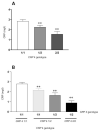Polymorphism at the C-reactive protein locus influences gene expression and predisposes to systemic lupus erythematosus
- PMID: 14645206
- PMCID: PMC3707088
- DOI: 10.1093/hmg/ddh021
Polymorphism at the C-reactive protein locus influences gene expression and predisposes to systemic lupus erythematosus
Abstract
Relative deficiency of pentraxin proteins is implicated in the pathogenesis of systemic lupus erythematosus. The C-reactive protein (CRP) response is defective in patients with acute flares of disease, and mice with targeted deletions of the serum amyloid P component gene (Sap) develop a lupus-like illness. In humans, the genes for CRP (CRP) and SAP (APCS) map to 1q23.2 within an interval linked with SLE. We have investigated the candidate genes CRP and APCS in two cohorts totalling 586 UK simplex SLE families. The inheritance of an intronic dinucleotide repeat and seven single nucleotide polymorphisms in the CRP and APCS genes was examined by application of family-based tests of association and linkage. Basal levels of CRP were influenced independently by two polymorphisms at the CRP locus, CRP 2 and CRP 4. Furthermore, the latter polymorphism was linked/associated with SLE and antinuclear autoantibody production. Thus, the polymorphism associated with reduced basal CRP was also associated with the development of SLE. These data support the hypothesis that defective disposal of potentially immunogenic material is a contributory factor in lupus pathogenesis. The identification of polymorphisms that determine basal CRP levels has implications in ischaemic heart disease, where CRP level is an important predictor of risk.
Figures




Similar articles
-
C-reactive protein gene polymorphisms in disease susceptibility and clinical manifestations of Korean systemic lupus erythematosus.J Rheumatol. 2009 Oct;36(10):2238-43. doi: 10.3899/jrheum.090243. Epub 2009 Sep 15. J Rheumatol. 2009. PMID: 19755616
-
Genetic variation in C-reactive protein (CRP) gene may be associated with risk of systemic lupus erythematosus and CRP concentrations.J Rheumatol. 2008 Nov;35(11):2171-8. doi: 10.3899/jrheum.080262. Epub 2008 Sep 15. J Rheumatol. 2008. PMID: 18793001 Free PMC article.
-
C-reactive protein +1444CT (rs1130864) genetic polymorphism is associated with the susceptibility to systemic lupus erythematosus and C-reactive protein levels.Clin Rheumatol. 2017 Aug;36(8):1779-1788. doi: 10.1007/s10067-017-3695-5. Epub 2017 Jun 1. Clin Rheumatol. 2017. PMID: 28567557
-
Update on human systemic lupus erythematosus genetics.Curr Opin Rheumatol. 2004 Sep;16(5):513-21. doi: 10.1097/01.bor.0000132648.62680.81. Curr Opin Rheumatol. 2004. PMID: 15314487 Review.
-
Interferon-inducible Ifi200-family genes in systemic lupus erythematosus.Immunol Lett. 2008 Aug 15;119(1-2):32-41. doi: 10.1016/j.imlet.2008.06.001. Epub 2008 Jul 1. Immunol Lett. 2008. PMID: 18598717 Free PMC article. Review.
Cited by
-
Association study of CRP gene in systemic sclerosis in European Caucasian population.Rheumatol Int. 2014 Mar;34(3):389-92. doi: 10.1007/s00296-013-2673-8. Epub 2013 Feb 9. Rheumatol Int. 2014. PMID: 23397258
-
Serum C-Reactive Protein (CRP), Target for Therapy or Trouble?Biomark Insights. 2007 Feb 7;1:77-80. Biomark Insights. 2007. PMID: 19690638 Free PMC article.
-
Current topics in human SLE genetics.Springer Semin Immunopathol. 2006 Oct;28(2):97-107. doi: 10.1007/s00281-006-0031-6. Epub 2006 Aug 29. Springer Semin Immunopathol. 2006. PMID: 16941108 Review.
-
Exploring the etiopathogenesis of systemic lupus erythematosus: a genetic perspective.Immunogenetics. 2019 Apr;71(4):283-297. doi: 10.1007/s00251-019-01103-2. Epub 2019 Jan 22. Immunogenetics. 2019. PMID: 30671674 Review.
-
Lack of the long pentraxin PTX3 promotes autoimmune lung disease but not glomerulonephritis in murine systemic lupus erythematosus.PLoS One. 2011;6(5):e20118. doi: 10.1371/journal.pone.0020118. Epub 2011 May 27. PLoS One. 2011. PMID: 21637713 Free PMC article.
References
-
- Morrow WJ, Nelson JL, Watts R, Isenberg DA. Autoimmune Rheumatic Disease. 2nd edn Oxford University Press; Oxford: 1999. pp. 56–103.
-
- Pisetsky DS. Anti-DNA and autoantibodies. Curr. Opin. Rheumatol. 2000;12:364–368. - PubMed
-
- Deapen D, Escalante A, Weinrib L, Horwitz D, Bachman B, Roy-Burman P, Walker A, Mack TM. A revised estimate of twin concordance in systemic lupus erythematosus. Arthritis Rheum. 1992;35:311–318. - PubMed
-
- Vyse TJ, Kotzin BL. Genetic susceptibility to systemic lupus erythematosus. A. Rev. Immunol. 1998;16:261–292. - PubMed
Publication types
MeSH terms
Substances
Grants and funding
LinkOut - more resources
Full Text Sources
Other Literature Sources
Medical
Molecular Biology Databases
Research Materials
Miscellaneous

